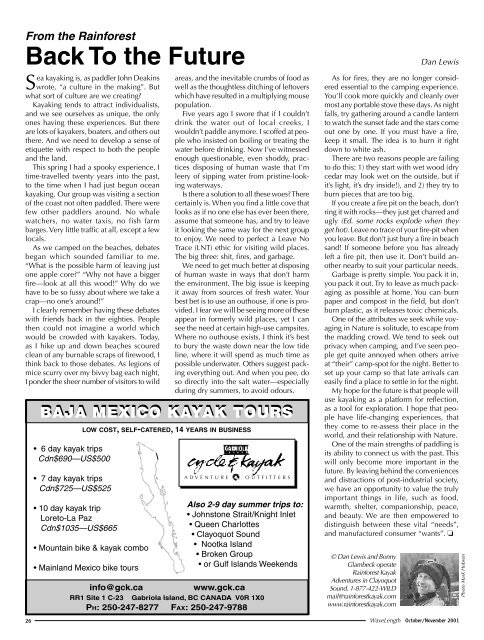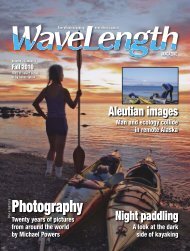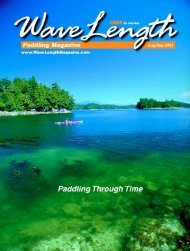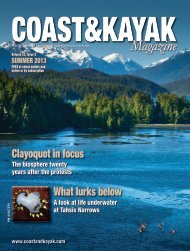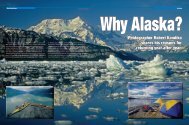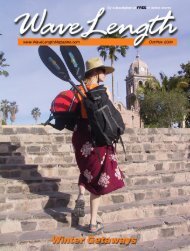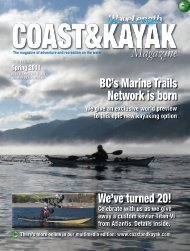Only Ocean Kayaking - WaveLength Paddling Magazine
Only Ocean Kayaking - WaveLength Paddling Magazine
Only Ocean Kayaking - WaveLength Paddling Magazine
You also want an ePaper? Increase the reach of your titles
YUMPU automatically turns print PDFs into web optimized ePapers that Google loves.
From the Rainforest<br />
Back To the Future<br />
Sea kayaking is, as paddler John Deakins<br />
wrote, “a culture in the making”. But<br />
what sort of culture are we creating?<br />
<strong>Kayaking</strong> tends to attract individualists,<br />
and we see ourselves as unique, the only<br />
ones having these experiences. But there<br />
are lots of kayakers, boaters, and others out<br />
there. And we need to develop a sense of<br />
etiquette with respect to both the people<br />
and the land.<br />
This spring I had a spooky experience. I<br />
time-travelled twenty years into the past,<br />
to the time when I had just begun ocean<br />
kayaking. Our group was visiting a section<br />
of the coast not often paddled. There were<br />
few other paddlers around. No whale<br />
watchers, no water taxis, no fish farm<br />
barges. Very little traffic at all, except a few<br />
locals.<br />
As we camped on the beaches, debates<br />
began which sounded familiar to me.<br />
“What is the possible harm of leaving just<br />
one apple core?” “Why not have a bigger<br />
fire—look at all this wood!” Why do we<br />
have to be so fussy about where we take a<br />
crap—no one’s around!”<br />
I clearly remember having these debates<br />
with friends back in the eighties. People<br />
then could not imagine a world which<br />
would be crowded with kayakers. Today,<br />
as I hike up and down beaches scoured<br />
clean of any burnable scraps of firewood, I<br />
think back to those debates. As legions of<br />
mice scurry over my bivvy bag each night,<br />
I ponder the sheer number of visitors to wild<br />
areas, and the inevitable crumbs of food as<br />
well as the thoughtless ditching of leftovers<br />
which have resulted in a multiplying mouse<br />
population.<br />
Five years ago I swore that if I couldn’t<br />
drink the water out of local creeks, I<br />
wouldn’t paddle anymore. I scoffed at people<br />
who insisted on boiling or treating the<br />
water before drinking. Now I’ve witnessed<br />
enough questionable, even shoddy, practices<br />
disposing of human waste that I’m<br />
leery of sipping water from pristine-looking<br />
waterways.<br />
Is there a solution to all these woes? There<br />
certainly is. When you find a little cove that<br />
looks as if no one else has ever been there,<br />
assume that someone has, and try to leave<br />
it looking the same way for the next group<br />
to enjoy. We need to perfect a Leave No<br />
Trace (LNT) ethic for visiting wild places.<br />
The big three: shit, fires, and garbage.<br />
We need to get much better at disposing<br />
of human waste in ways that don’t harm<br />
the environment. The big issue is keeping<br />
it away from sources of fresh water. Your<br />
best bet is to use an outhouse, if one is provided.<br />
I fear we will be seeing more of these<br />
appear in formerly wild places, yet I can<br />
see the need at certain high-use campsites.<br />
Where no outhouse exists, I think it’s best<br />
to bury the waste down near the low tide<br />
line, where it will spend as much time as<br />
possible underwater. Others suggest packing<br />
everything out. And when you pee, do<br />
so directly into the salt water—especially<br />
during dry summers, to avoid odours.<br />
BAJA MEXICO KAYAK TOURS<br />
BAJA MEXICO KAYAK TOURS<br />
• 6 day kayak trips<br />
Cdn$690—US$500<br />
• 7 day kayak trips<br />
Cdn$725—US$525<br />
• 10 day kayak trip<br />
Loreto-La Paz<br />
Cdn$1035—US$665<br />
LOW COST, SELF-CATERED, 14 YEARS IN BUSINESS<br />
• Mountain bike & kayak combo<br />
• Mainland Mexico bike tours<br />
A D V E N T U R E O U T F I T T E R S<br />
Also 2-9 day summer trips to:<br />
• Johnstone Strait/Knight Inlet<br />
• Queen Charlottes<br />
• Clayoquot Sound<br />
• Nootka Island<br />
• Broken Group<br />
• or Gulf Islands Weekends<br />
info@gck.ca www.gck.ca<br />
RR1 Site 1 C-23 Gabriola Island, BC CANADA V0R 1X0<br />
PH: 250-247-8277 FAX: 250-247-9788<br />
As for fires, they are no longer considered<br />
essential to the camping experience.<br />
You’ll cook more quickly and cleanly over<br />
most any portable stove these days. As night<br />
falls, try gathering around a candle lantern<br />
to watch the sunset fade and the stars come<br />
out one by one. If you must have a fire,<br />
keep it small. The idea is to burn it right<br />
down to white ash.<br />
There are two reasons people are failing<br />
to do this: 1) they start with wet wood (dry<br />
cedar may look wet on the outside, but if<br />
it’s light, it’s dry inside!), and 2) they try to<br />
burn pieces that are too big.<br />
If you create a fire pit on the beach, don’t<br />
ring it with rocks—they just get charred and<br />
ugly (Ed. some rocks explode when they<br />
get hot). Leave no trace of your fire-pit when<br />
you leave. But don’t just bury a fire in beach<br />
sand! If someone before you has already<br />
left a fire pit, then use it. Don’t build another<br />
nearby to suit your particular needs.<br />
Garbage is pretty simple. You pack it in,<br />
you pack it out. Try to leave as much packaging<br />
as possible at home. You can burn<br />
paper and compost in the field, but don’t<br />
burn plastic, as it releases toxic chemicals.<br />
One of the attributes we seek while voyaging<br />
in Nature is solitude, to escape from<br />
the madding crowd. We tend to seek out<br />
privacy when camping, and I’ve seen people<br />
get quite annoyed when others arrive<br />
at “their” camp-spot for the night. Better to<br />
set up your camp so that late arrivals can<br />
easily find a place to settle in for the night.<br />
My hope for the future is that people will<br />
use kayaking as a platform for reflection,<br />
as a tool for exploration. I hope that people<br />
have life-changing experiences, that<br />
they come to re-assess their place in the<br />
world, and their relationship with Nature.<br />
One of the main strengths of paddling is<br />
its ability to connect us with the past. This<br />
will only become more important in the<br />
future. By leaving behind the conveniences<br />
and distractions of post-industrial society,<br />
we have an opportunity to value the truly<br />
important things in life, such as food,<br />
warmth, shelter, companionship, peace,<br />
and beauty. We are then empowered to<br />
distinguish between these vital “needs”,<br />
and manufactured consumer “wants”. ❏<br />
© Dan Lewis and Bonny<br />
Glambeck operate<br />
Rainforest Kayak<br />
Adventures in Clayoquot<br />
Sound. 1-877-422-WILD<br />
mail@rainforestkayak.com<br />
www.rainforestkayak.com<br />
Dan Lewis<br />
26 <strong>WaveLength</strong> October/November 2001<br />
Photo Mark Hobson


